If you need to paint a barn you should follow up a few tips. A barn is often built of spruce or pine wood or timber which is inclined to ‘deforms; due to moisture and changes in temperature the wood shrinks and swells.
Read about the experience of customers who used Moose Färg … Customer Experiences
Conventional wood paint forms a film on the wood. Because of wood shrinkage and swelling, even the best elastic paint eventually will flake. Moose Färg is ideal for this type of wood, and it has been used in Sweden for centuries as a practical, attractive and affordable solution. The ideal wood paint to paint a barn.
Paint a barn built of (impregnated) wood or timber
With new wood
The walls of gazebos, roofs and garden rooms are often made of spruce or pine, and are sometimes impregnated.
1. Degrease new (impregnated) smooth wood first with Polarsken soap and water, after drying, sand lightly with coarse-grained sandpaper (80 grit). Then apply 1 coat of paint.
2. You can get started right away with sawn non-impregnated wood. Graying wood that has been standing for a while can also be treated immediately with two layers, you only need to clean it.
3. With new wood it is advisable to wait a few months until the second layer, the wood still has to work and will form small cracks. After this you can apply the second layer.
For wood with an existing paint or stain layer
1. An existing paint or stain that is still in good condition has no cracks and is not flaked. It is very important that the underlayer does not peel off (detach) later on. So check the old layer carefully.
2. Where it peels, remove all loose paint completely. You can use the high-pressure sprayer for this (use the spray position so that the wood grain is not damaged). This can also be done with coarse-grained sandpaper. Sand in the direction of the wood fiber and after sanding remove the dust (and degrease) with soap and water.
3. Allow the wood to dry thoroughly, and then lightly roughen it again, so that the protection system adheres perfectly and the underlying paint does not peel off. If you want or need to do it more thoroughly, you can also burn off the paint.
4. Painting is then very easy: apply one layer with a block brush, let it dry and then the second layer. There’s no need to sand in-between painting the two layers. Make sure that the daytime temperature is above 15 degrees, then the paint is completely waterproof after 2 days. It should not rain for a few days.
To paint a standard small barn, about 3×4 meters of ground surface generally 3 buckets of 4 liters are needed (covering appr. 75 m2), two with colour and one with contrast colour. You will usually have to paint twice and do some touching up at the end of the season.
In case you want to try Moose Färg colour combinations , make your own colour combinations here.
If it is new and impregnated wood, give it some time to breathe. The impregnation often transpires. If you still need to put it together, it is wise to first paint the tongue and groove and possibly give it a first thin layer. This prevents shrinking and swelling joints and also preserves the tongue and groove the best,
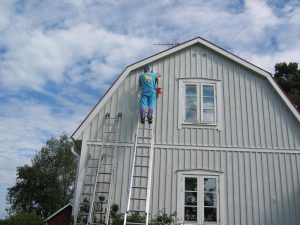
Do not forget to grease your nails with some linseed oil. This prevents rust and moisture penetration, even when working with stainless steel nails . And especially if you are not hammering the nails, but driving them in with a nail gun. Nail guns make a bigger hole and that has to be filled up!
Moose F is also suitable for wood that has already been painted, provided that the substrate is well pre-treated.
Clean the wood thoroughly, for example with a pressure washer and Polarsken linseed oil soap. Use the spray setting so the wood structure will not be damaged and spray first with a solution of green soap. Make sure you do not spray in the insulation!
Moose Färg is excellent for painting the wood and timber of your barn
Even if the timber has already been impregnated, painted or stained, the extra addition of Moose F ensures the best result. The often heard rumour that waterborne paint is not applicable on solvent based paint is not correct. It depends greatly on whether the types of paint are compatible with one another. F type can be used perfectly well in most situations, provided that the pre-treatment is done well (rough sanding, degreasing, letting the first coat dry thoroughly).
In sporadic cases, the surface turns out to be incompatible, which can be concluded when the F type makes little ‘figures’(this is a surface tension effect). Then it just will not work. This does not happen often, but for example Sikkens Amerol does not adhere. The best thing to do, is just to try it out.
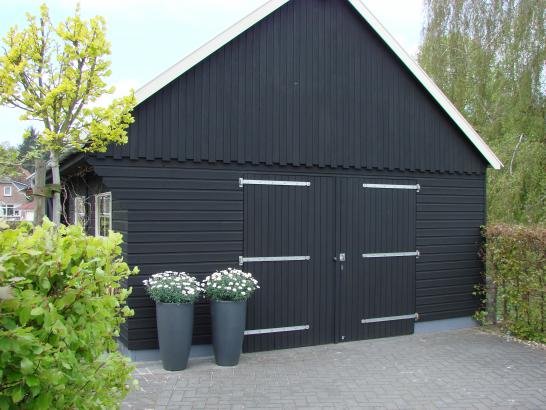
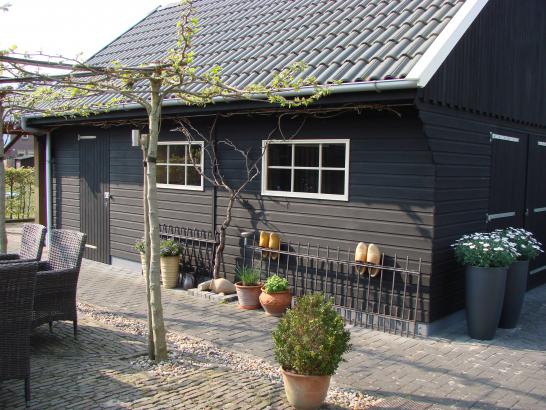
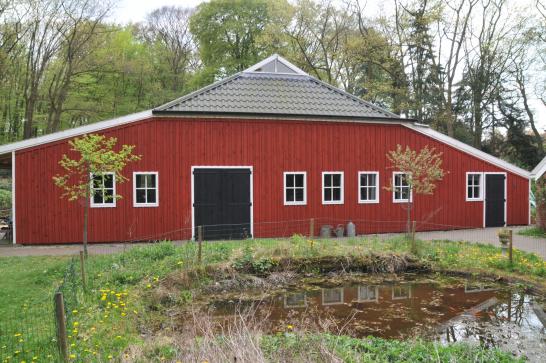
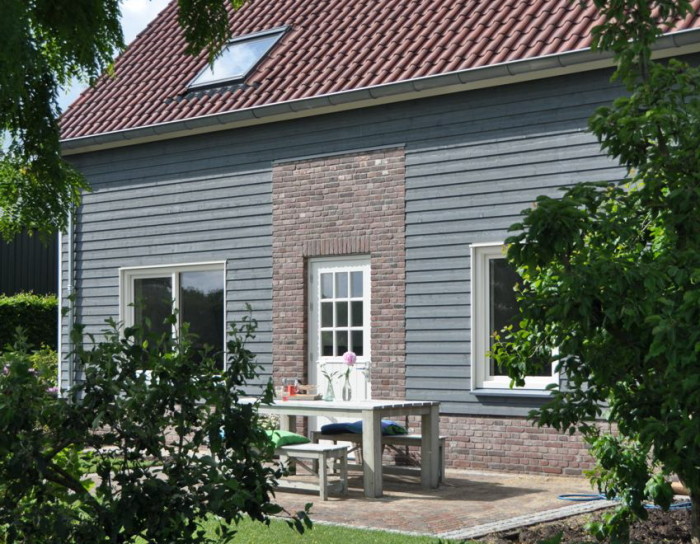
If you want to paint a barn, then treat it where necessary against weathering,
which often causes mould. The weather does not like chlorine. (…) or use Grund, anti mould pretreatment, mail for more info
Give shiny surfaces a good sanding. Avoid ending up with large areas of bare wood and large areas of painted wood. Due to the difference in vapour permeability, it can become visible later on.
Then paint the first coat with water diluted Moose F paint (approx. 10 % ) with a block brush so you can really get into the cracks and holes. Apply the second layer after the first layer has dried thoroughly. For painted wood this can last up to a day, but on a sunny, dry day this can be the case after only two hours. You will notice it; when the second layer dissolves the first again, then you have to wait. Priming is not necessary, for Moose Färg is its own primer. Do not sand between the coats of paint, that is not necessary or even undesirable.
If the wood is too dry (if it has been very hot and dry), then moisten it lightly before painting. If the wood is too fresh there can still be some moisture in the wood. Air-dry, 17.9 % moisture is ideal. Fresh wood bleeds and its juices can be seen through the paint. Which is not such a great disaster actually, because you can paint it over again just fine.
To order Moose Färg paint for your barn click here
Check the paint towards the end of the season, or after the winter. The surface sucks up the paint a lot so it is possible that not all areas are covered as well. Touching up here and there, or lightly repainting everything, is not visible later on and it ensures optimum results for years to come.

